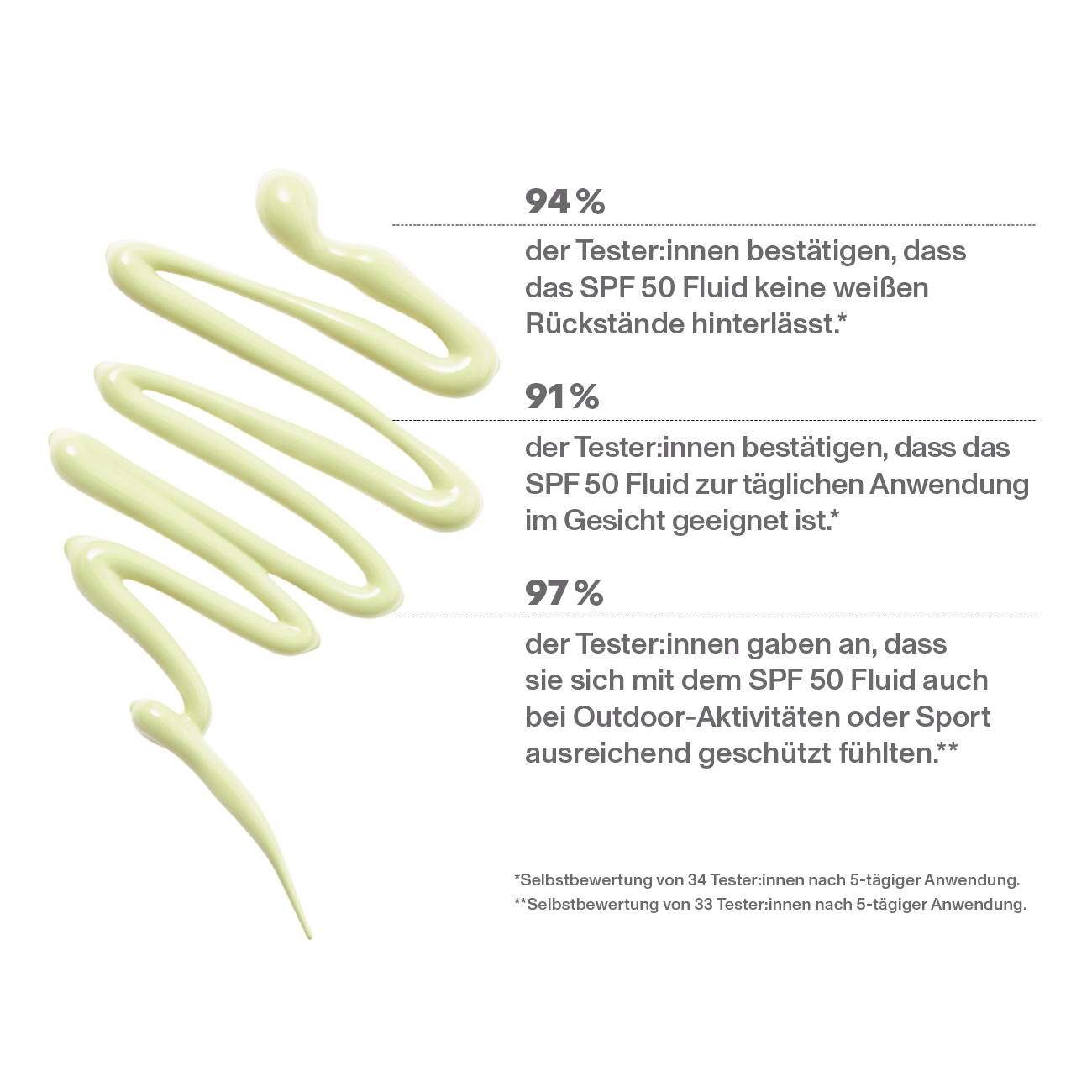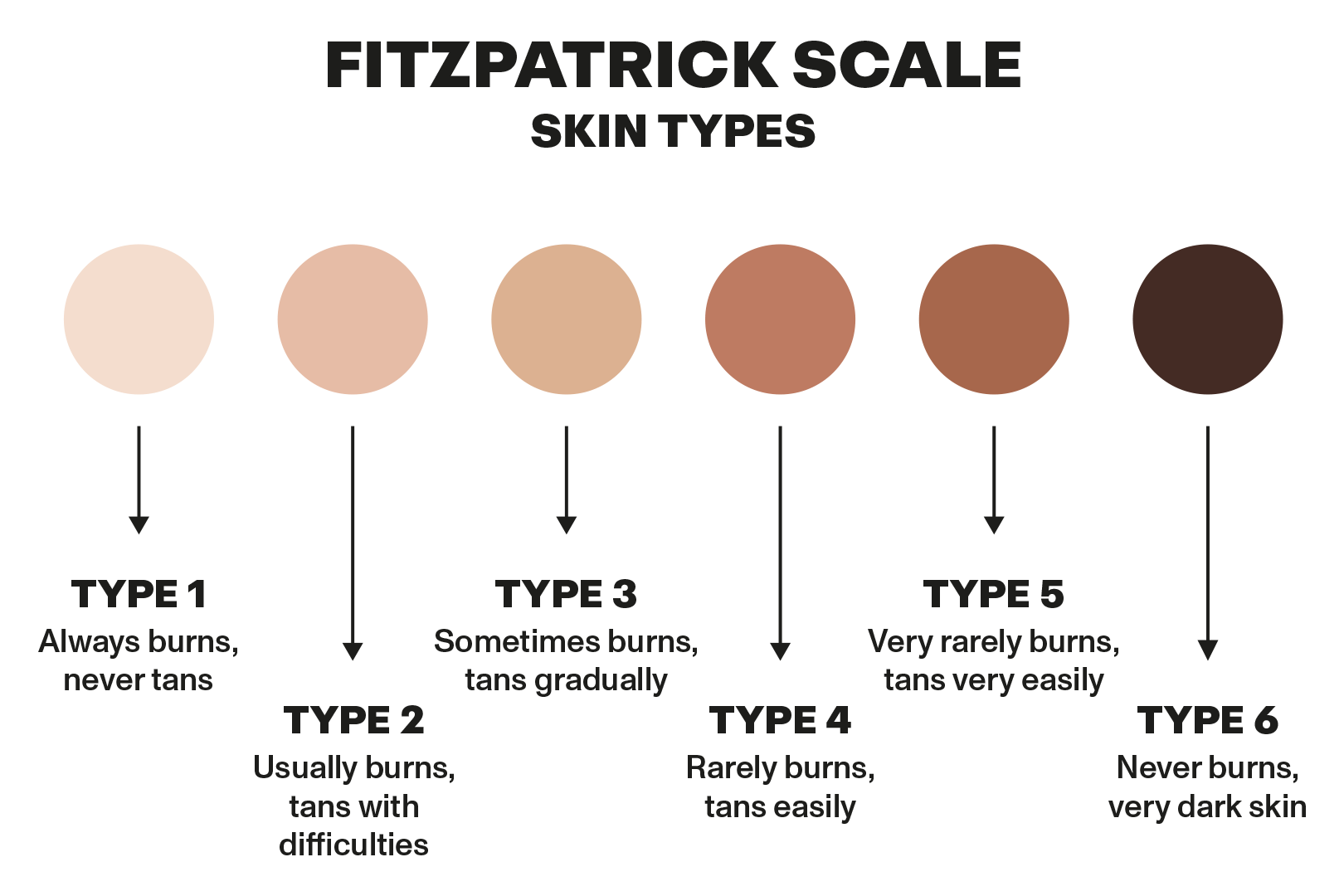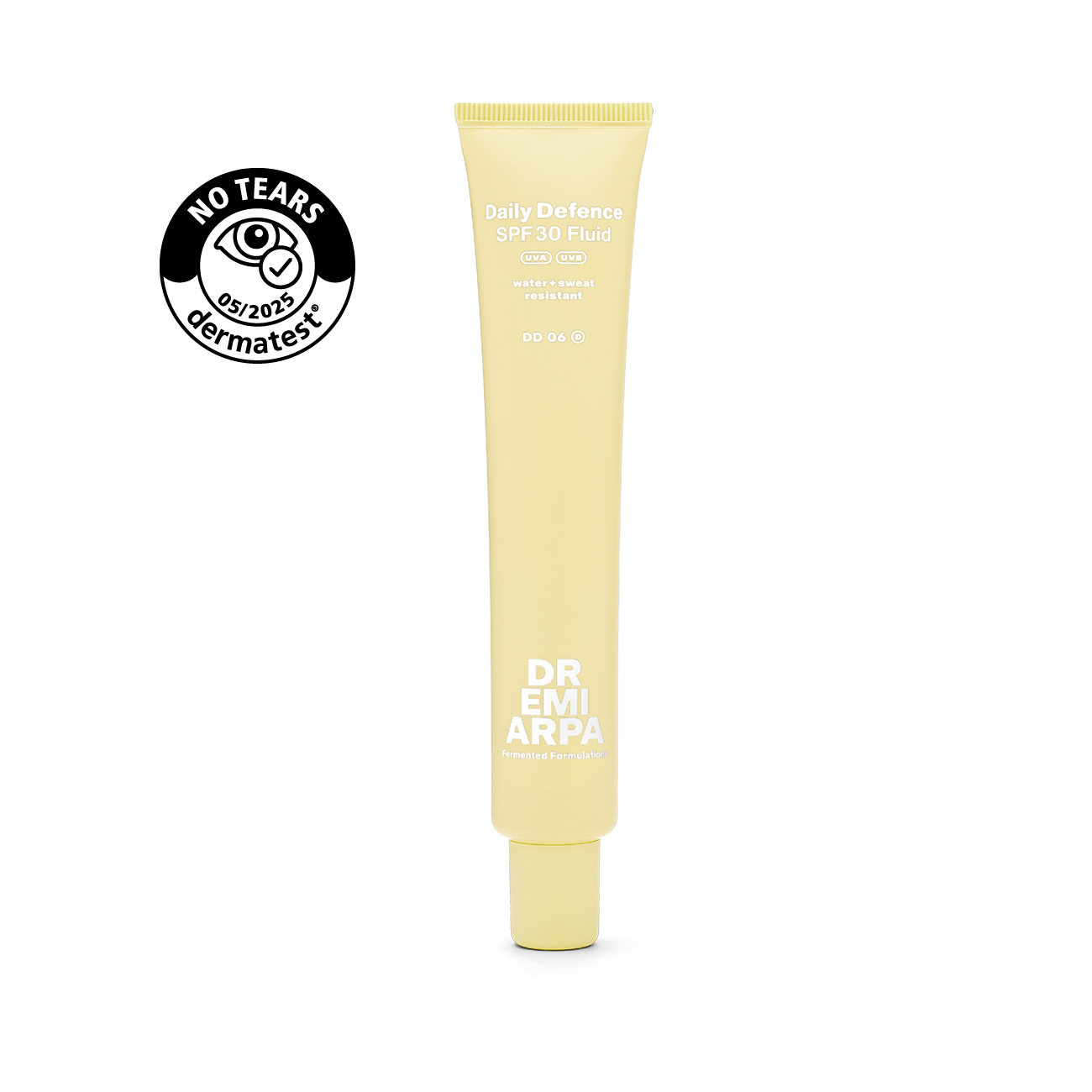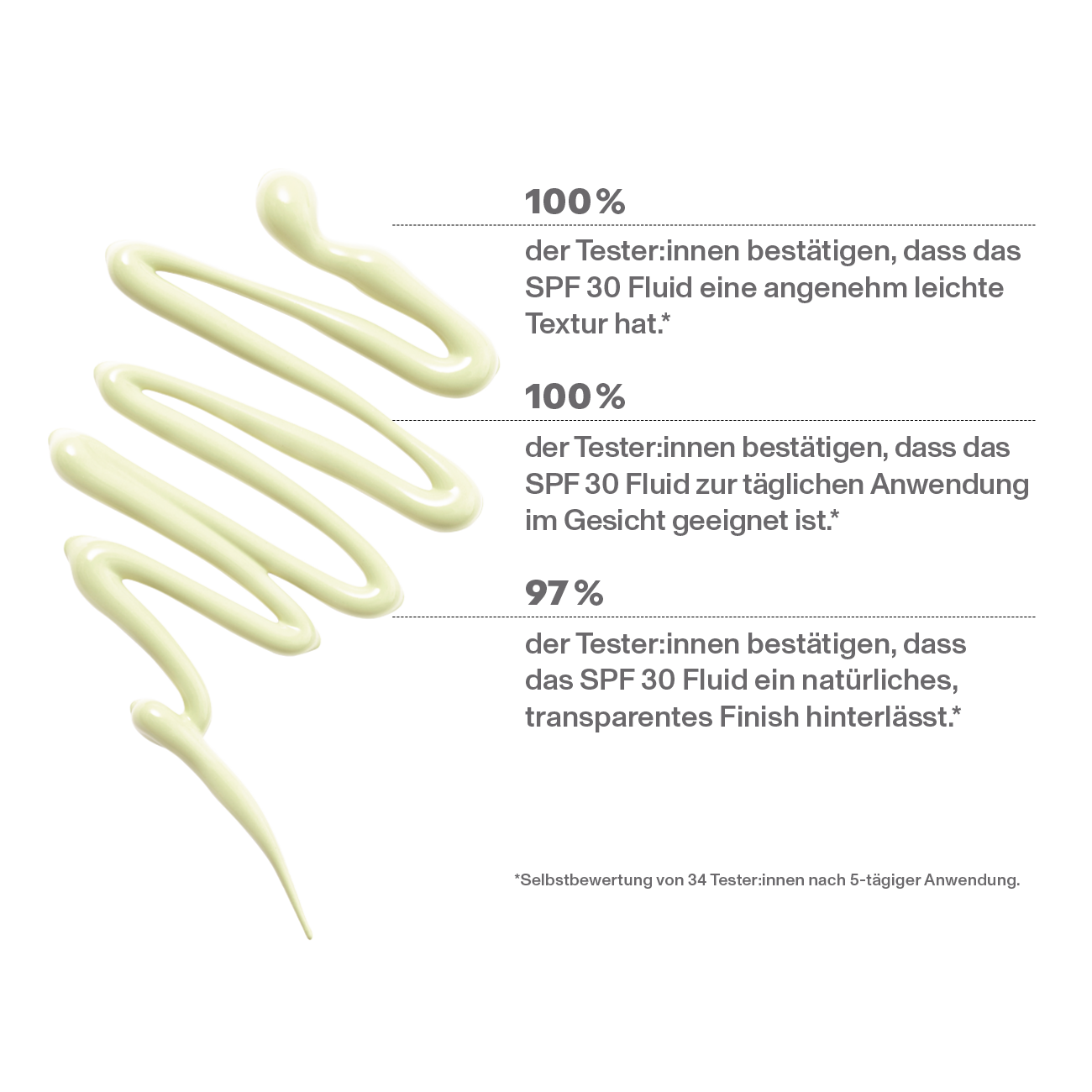LIGHT PROTECTION FACTOR EXPLAINED

LIGHT PROTECTION FACTOR EXPLAINED
What is behind the term SPF and how much sun protection does the skin really need? This article provides scientifically sound answers to frequently asked questions about SPF and UV protection.
Are you looking for all-round protection for every day? The Daily Defense Set protects against UV radiation with sunscreen, oxidative damage with antioxidant serum and your lips with Sheer Shield Balm with SPF 50+. Go directly to the store here:
It's nothing new that sun protection is important. But what do SPF, SPF, sun protection factor, UVA, UVB and all the other related terms mean? We'll tell you everything you need to know to protect your skin in the best possible way.
WHAT DO LIGHT PROTECTION FACTOR AND SPF MEAN?
SPF stands for "Sun Protection Factor", and is the abbreviation for sun protection factor (SPF) in German, also known as Sonnenschutzfaktor. The SPF describes how much longer you can theoretically stay in the sun with sun protection without getting sunburned compared to unprotected skin. The basis for calculating the sun protection factor is the following formula:
SPF × skin's own protection time = theoretical duration of protection
For example, if your skin shows the first signs of sunburn after ten minutes without protection, a correctly applied SPF 50 provides up to 500 minutes of protection. But beware: this calculation is based on standardized laboratory conditions - in reality, many other factors play a role. And: the focus of this calculation is on sunburn. Other long-term damage is not taken into account, even if our skin does not forget it. The resulting consequences, such as premature skin ageing or skin cancer, can become apparent years later and then become acute. This means that skin damage occurs even without sunburn.
Which sun protection factor do I need: sun protection factor 50 or 30?
The sun protection factor (SPF) indicates how well a product protects against UVB radiation. The higher the SPF, the higher the protective performance. A distinction is made between different protection categories. The following sun protection factor table shows you how SPF values and UVA protection can be classified.

Both the Daily Defense SPF 30 Fluid and the SPF 50 Fluid from DR. EMI ARPA SKIN belong to the "High protection" category, i.e. with high sun protection for the skin. They help to prevent UV-related skin damage such as sunburn. A rough guide for everyday use: sun protection with SPF 30 or SPF 50 is always advisable, the SPF depends on the situation and skin type. Although products with SPF 100 are available, they are not commonly used, as even sunscreens with the highest SPF cannot filter out all UV radiation. According to the EU Commission, claims such as "100 percent protection" or "sun blocker" are considered dubious and must not be used as they convey a false sense of security. Sunscreen products must also carry clear warnings indicating that 100% protection is not possible. They should make it clear to consumers that additional precautionary measures, such as avoiding intense sunlight, are still necessary.







SPF 50 Fluid
SPF 50 offers a high level of UV protection.
Postbiotic strengthens the skin's own protective function.
Ectoin has a moisturizing effect.
Vitamin E has an antioxidant effect.
Your daily defense!
UV radiation: What is the difference between UVA, UVB and UVC?
Ultraviolet (UV) radiation mainly consists of two components that affect our skin in different ways: UVA and UVB rays. Both penetrate the skin with different energy and penetration depth, causing different biological effects.
UVA rays (320-400 nm) make up around 95% of the UV radiation that reaches the earth's surface. They penetrate deep into the dermis and cause long-term damage, for example through oxidative stress, which leads to the destruction of collagen fibers, the formation of wrinkles and loss of elasticity. This process is known as photoaging.
UVB radiation (280-320 nm) is more energetic, but only penetrates as far as the epidermis. There it causes acute DNA damage, which manifests itself clinically as sunburn (erythema). Both UV types, i.e. UVA and UVB, are carcinogenic if the skin is exposed uncontrollably or repeatedly. UVB, however, is considered the main trigger for skin cancer - especially malignant melanoma and squamous cell carcinoma.
Sun protection must therefore always offer both UVA and UVB protection - not only to prevent wrinkles or pigmentation spots, but also as a preventative measure against skin cancer.
UVC radiation (100-280 nm) has a low penetration depth into the skin. UVC radiation is completely filtered by the earth's atmosphere and does not occur naturally on the earth's surface. It is only generated artificially and is used to disinfect surfaces, among other things, but should never be applied directly to the skin or eyes.
Reapplying cream = maintaining, not prolonging
It is essential that sunscreens are reapplied regularly. The sentence "Reapplying sunscreen does not extend the duration of protection" therefore sounds contradictory at first. The duration of protection is calculated once by multiplying the sun protection factor by the skin's own individual protection. And this is where it gets interesting: it is not extended by reapplying cream, as this only serves to maintain protection.
Daily sun cream is worn off or reduced by sweat, water, mechanical friction (e.g. clothing, towel) or incomplete application. Over time, the effective protective effect decreases, even if the theoretical duration of protection has not yet been reached.
Scientific digression: SPF test
In the EU, sun protection products are classified as cosmetic products and are subject to Regulation (EC) 1223/2009. However, additional requirements apply due to their specific protective function. For example, a standardized SPF test according to ISO 24444:2019 must be carried out to determine the sun protection factor. This is an internationally recognized in-vivo test in which test subjects are used to measure how long it takes for a sunburn to develop on unprotected skin compared to skin treated with sunscreen. The SPF value determined indicates how much longer a person with sunscreen can be exposed to the sun without getting sunburnt.
What does self-protection time mean and what time do I have?
Our skin has a natural protection mechanism against UV radiation - the so-called self-protection time. It describes how long the skin can be exposed to the sun without additional sun protection before the first UV-related damage such as redness or sunburn occurs.
This period is individual and depends on the skin type. While very light skin types (type 1) only have 5-10 minutes of self-protection time, darker skin types (type 6) have up to 90 minutes. Skin types are classified according to the so-called Fitzpatrick scale. It helps to determine the right sun protection for the respective skin type - and helps you decide, for example, whether you should use sun cream with SPF 30 or SPF 50.
But even if our skin offers a certain degree of protection, this is not enough - because UV rays have a much deeper and more intensive effect than many people think. This is why sun protection products are essential, regardless of skin type.
Which sun protection factor is the right one? Regardless of skin phototype and self-protection time, sun protection factor 50 always makes sense. Especially if the application method, activity level or external influences reduce the protective effect in everyday life.
What are the six skin phototypes according to Fitzpatrick?
The six skin phototypes according to Fitzpatrick were introduced in 1975 by the US dermatologist Thomas B. Fitzpatrick in order to create a practical classification that could be used to better assess the individual sun sensitivity of patients. Originally, this classification was not used for cosmetic skin care, but for medical phototherapy. Fitzpatrick developed a scale based on two observations: the tendency to sunburn within the first 24 hours of sun exposure and the skin's ability to develop a tan within a week.
This was the basis for the classification into six skin phototypes:
- Type 1: Very fair skin with many freckles. Never tans, but reddens quickly in the sun.
- Type 2: Light skin with freckles. Hardly to moderately tanned, often sunburnt.
- Type 3: Light to light brown skin, rarely freckles. Tans faster than type 2, but sunburn can still occur.
- Type 4: Light brown, olive-colored skin that tans quickly in the sun.
- Type 5: Dark brown skin, sunburn rarely occurs. Reddening of the skin after UV exposure is atypical or barely visible.
- Type 6: Dark skin, very high inherent pigmentation, sunburn is very rare, redness is usually not visible.

Today, the Fitzpatrick classification is used in a variety of ways. It is used to estimate the individual risk of UV-induced skin damage and skin cancer, is used for the dosage of light and laser treatments and is also established in clinical studies. Nevertheless, the system is not without controversy, particularly with regard to its validity for people with dark skin.
Criticism of the Fitzpatrick scale
The Fitzpatrick scale was originally developed for fair-skinned patients and later expanded to include darker skin types - but without adapting the methodological principles. A central point of criticism is that the system equates skin color and photosensitivity, although both can vary independently of each other. It is therefore entirely possible that darker skin also reacts sensitively to UV radiation, for example due to a higher proportion of the less protective pheomelanin.
Despite these limitations, the scale has been a practical tool for many years to enable a rough assessment of sun sensitivity - for example, to find out which sun cream with which sun protection factor is the right one. While people with fair skin (type 1-2) are generally advised to use sun cream with SPF 50, SPF 30 may also be sufficient for more robust skin types (e.g. type 4) with a lower tendency to sunburn in everyday situations. However, it is now known that the subjective assessment of skin reactions is not always reliable and that individual perceptions can influence the result. It is therefore increasingly recommended to consider photosensitivity and pigmentation separately and not to assess the need for sun protection solely on the basis of phototypes. Dark skin can also be damaged by UV radiation, albeit less often visibly through sunburn. The risk of DNA damage from UV rays in the form of premature skin ageing and skin cancer is also present here, albeit lower. The following therefore applies: sun protection is important for all skin types, including types 5 and 6.







SPF 30 Fluid
SPF 30 offers a high level of UV protection.
Postbiotic strengthens the skin's own protective function.
Ectoin has a moisturizing effect.
Vitamin E has an antioxidant effect.
Your daily defense!
SUN PROTECTION: THE RIGHT APPLICATION
For sun protection to be fully effective, it is important to apply it correctly. The so-called 3-finger rule helps with the dosage: three finger-length strips of sun cream are recommended for the face, neck and décolleté. Around 30 milliliters are needed for the entire body, which corresponds to a well-filled palm or, for example, a shot glass. It is also important to apply sunscreen to often forgotten areas such as ears, the back of the feet or the hairline and scalp.
The cream should be applied 15-30 minutes before sun exposure and reapplied every two hours and after bathing or drying off. Make sure that your product offers both a sufficiently high SPF (at least SPF 30) and UVA protection.
KEY TAKEAWAYS
A high SPF for the skin is important - but only one part of the whole. The sun protection factor (SPF) indicates how long the skin is theoretically protected from sunburn. However, this protection period is not extended by reapplying sunscreen, but is maintained by it. The self-protection time itself is individual and depends on the skin type. However, sun protection always makes sense, regardless of skin type.
UVB rays are responsible for sunburn, while UVA rays penetrate deeper into the skin and, above all, accelerate premature skin ageing. A reliable sunscreen must protect against both - with SPF 30 (high protection) or SPF 50 (high protection), depending on the skin type and situation. A combination of UVB, UVA and broad-spectrum filters is therefore essential. Because a good sun cream is more than just a high SPF: it reliably protects against UVA and UVB radiation, feels good on the skin and therefore becomes a daily companion.
The SPF fluids from DR. EMI ARPA SKIN combine modern, chemical UV filters for broadband protection against UVB and UVA radiation and thus help to prevent sunburn, light-induced skin ageing and long-term skin damage such as skin cancer. It is not just the SPF value that is decisive here, but the entire formulation - with light textures, skin-caring ingredients and low irritation potential that make daily use pleasant.
FAQ
Sun cream protects the skin by containing UV filters that absorb harmful UV radiation and, if necessary, partially reflect it. This prevents the majority of UVB and UVA rays from penetrating the skin and causing damage such as sunburn, premature skin ageing or cell changes such as skin cancer.
The possible duration depends on the skin type. The rule of thumb is: self-protection time × sun protection factor. With a self-protection time of 10 minutes and a sun protection factor of 50, this would theoretically be 500 minutes. In reality, however, the protective effect is shortened, for example, by applying too little, sweating, water or abrasion. Regular reapplication is therefore crucial.
The effect of sun protection wears off after around two to three hours - regardless of the SPF. Protection can also be lost more quickly through water, sweat or friction. Therefore: reapply every two hours and after bathing or drying off.
One application is not enough. For optimum protection, apply sunscreen generously 15-30 minutes before going out in the sun and then reapply every two hours and after contact with water or a towel.
Yes - when used correctly, sun cream can effectively protect against sunburn, especially if it protects against both UVB and UVA radiation. It is important to apply the right amount and reapply regularly.
Sunscreens approved in the EU undergo strict safety assessments. There is no reliable evidence that correctly applied sunscreens are carcinogenic. On the contrary: sun creams are safe and help to reduce the risk of UV-induced skin cancer. UV radiation, on the other hand, is considered carcinogenic.
BASF Personal Care. (n.d.). The skin's own protection. Retrieved June 10, 2025, from https://www.personal-care.basf.com/core-competencies/alles-%C3%BCber-sonne/haut-hauttypen/der-eigenschutz-der-haut
BASF Personal Care. (n.d.). What exactly is this SPF/LSF & Co. Retrieved June 10, 2025, from https://www.personal-care.basf.com/core-competencies/alles-%C3%BCber-sonne/sonnenschutz/was-genau-ist-dieses-spf-lsf-co
Federal Office for Radiation Protection (BfS). (2025). UV protection with sunscreen. Retrieved May 19, 2025, from https://www.bfs.de/EN/topics/opt/uv/protection/sunscreen/sunscreen_node.html
Federal Office for Radiation Protection (BfS). (n.d.). Disinfection with UV-C radiation. Retrieved June 4, 2025, from https://www.bfs.de/DE/themen/opt/anwendung-alltag-technik/uv/uv-c-strahlung/uv-c-desinfektion_node.html
Federal Office of Consumer Protection and Food Safety (BVL). (n.d.). Sunscreen products - requirements and labeling. Retrieved June 04, 2025, from https://www.bvl.bund.de/DE/Arbeitsbereiche/03_Verbraucherprodukte/02_Verbraucher/03_Kosmetik/06_Sonnenschutzmittel/bgs_kosmetik_sonnenschutzmittel_node.html
Busch, L., Kröger, M., Zamudio Díaz, D. F., Schleusener, J., Lohan, S. B., Ma, J., Witzel, C., Keck, C. M., & Meinke, M. C. (2023). Far-UVC- and UVB-induced DNA damage depending on skin type. Experimental Dermatology, 32(9), 1582-1587.
Callewaert, C., Ravard Helffer, K., & Lebaron, P. (2020). Skin microbiome and its interplay with the environment. American Journal of Clinical Dermatology, 21(Suppl 1), 4-11.
Fajuyigbe, D., & Verschoore, M. (2021). Sun exposure and Black skin. In Current Problems in Dermatology (Vol. 55, pp. 62-71).
Fitzpatrick, T. B. (1988). The validity and practicality of sun-reactive skin types I through VI. Archives of Dermatology, 124(6), 869-871.
Gupta, V., & Sharma, V. K. (2019). Skin typing: Fitzpatrick grading and others. Clinics in Dermatology, 37(5), 430-436.
Lim, S. S., Mohammad, T. F., Kohli, I., Hamzavi, I., & Rodrigues, M. (2023). Optimization of skin phototype classification. Pigment Cell & Melanoma Research, 36(6), 468-471.
Neale, R. E., Khan, S. R., Lucas, R. M., Waterhouse, M., Whiteman, D. C., & Olsen, C. M. (2019). The effect of sunscreen on vitamin D: A review. British Journal of Dermatology, 181(5), 907-915.
Rittié, L., & Fisher, G. J. (2015). Natural and sun-induced aging of human skin. Cold Spring Harbor Perspectives in Medicine, 5(1).
Roberts, W. E. (2009). Skin type classification systems old and new. Dermatologic Clinics, 27(4), 529-533.
Tewari, A., Grage, M. M. L., Harrison, G. I., Sarkany, R., & Young, A. R. (2013). UVA1 is skin deep: Molecular and clinical implications. Photochemical & Photobiological Sciences, 12(1), 95-103.

















